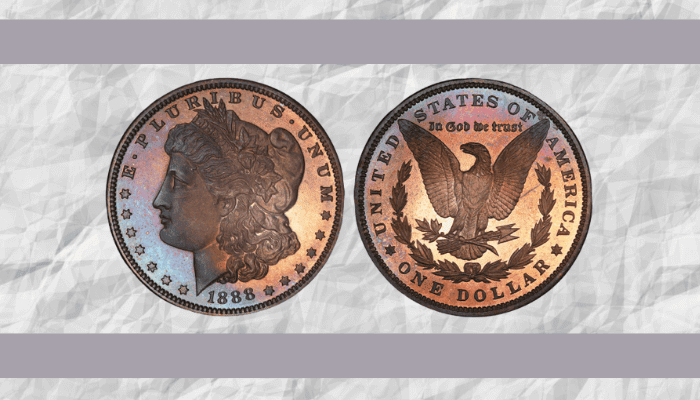Whispers of Silver: My First Encounter with a Legendary Coin
Let me take you back to a crisp autumn afternoon in a small antique shop in downtown Chicago. The year was 1987, and little did I know that a dusty display case would change my life forever. There, nestled between worn pocket watches and tarnished silverware, sat an 1888 Silver Dollar that would become the cornerstone of my decades-long numismatic passion.
The Moment of Discovery
When I first held that coin, something magical happened. The weight, the intricate details, the subtle patina—each element told a story far beyond its monetary value. This wasn‘t just a piece of currency; it was a time capsule, a tangible connection to America‘s complex economic landscape of the late 19th century.
The Historical Tapestry: Understanding the 1888 Silver Dollar‘s Origins
The Morgan Dollar series represents more than mere metal and monetary exchange. It‘s a testament to a tumultuous period in American economic history. The year 1888 was particularly significant, emerging from the shadows of the Bland-Allison Act of 1878—legislation that mandated the U.S. Treasury purchase massive quantities of silver, essentially propping up a struggling mining industry.
Political Alchemy: Transforming Silver into Currency
Imagine the political maneuvering behind each coin‘s creation. Powerful silver mining interests in western states like Colorado and Nevada lobbied aggressively, convincing Congress to create demand for their precious metal. The Morgan Dollar became their economic lifeline, a brilliant piece of legislative engineering.
Minting Mysteries: The Three Legendary Locations
Not all 1888 Silver Dollars were created equal. Three primary mints—Philadelphia, New Orleans, and San Francisco—produced these remarkable coins, each with its unique characteristics and production nuances.
Philadelphia: The Prolific Producer
The Philadelphia Mint was the undisputed champion, striking an impressive 19,183,000 coins that year. These "no mint mark" dollars represent the standard, the baseline from which all variations would be measured. Yet, even within this massive production, subtle differences emerged that would fascinate collectors for generations.
New Orleans: A Southern Numismatic Treasure
The New Orleans Mint, with its 12,150,000 coins, told a different story. Each piece carried the subtle "O" mint mark, a small but significant identifier that could dramatically alter a coin‘s value. The southern mint‘s production reflected the region‘s economic resilience in the post-Reconstruction era.
San Francisco: The Rarest of Them All
Perhaps most intriguing was the San Francisco Mint, which produced a mere 657,000 coins. This scarcity transformed the 1888-S Silver Dollar into a true collector‘s holy grail. Imagine holding a coin so rare that fewer than a thousand might exist in pristine condition today!
The Art of Valuation: More Than Just Metal and Markings
Determining a Morgan Dollar‘s value is part science, part intuition. Factors like condition, mint mark, and historical provenance interplay in a complex dance that can turn a [${20] coin into a [${20,000] treasure.
Grading: The Numismatist‘s Fine Art
Professional coin grading is a meticulous process. Each coin is examined under specialized lighting, evaluated for wear, luster, and potential imperfections. A single point difference in grade can mean thousands of dollars in value.
Rare Varieties: The Collector‘s Ultimate Thrill
Some 1888 Silver Dollars transcend ordinary collectibility. Varieties like the famous "VAM-4 Hot Lips" error—where Liberty‘s lips appear slightly doubled—can command astronomical prices. These are not just coins; they‘re historical anomalies, each telling a unique story of human imperfection in mechanical precision.
Personal Preservation: Protecting Your Numismatic Treasure
As a seasoned collector, I cannot stress enough the importance of proper coin preservation. Modern environmental controls, specialized holders, and minimal handling are crucial. Think of each coin as a fragile manuscript, capable of disintegrating with careless touch.
Investment Potential: Beyond Mere Collecting
While passion drives most serious collectors, investment potential cannot be ignored. Morgan Dollars, especially rare 1888 specimens, have consistently demonstrated impressive appreciation. They represent a tangible asset that bridges historical significance with financial opportunity.
Market Trends: What Serious Collectors Know
The numismatic market is dynamic, influenced by collector interest, precious metal prices, and broader economic trends. An 1888 Silver Dollar purchased today could potentially be worth exponentially more in a decade.
The Human Connection: Why We Collect
Ultimately, coin collecting transcends mere financial considerations. Each Morgan Dollar carries whispers of human stories—of miners, politicians, everyday Americans navigating a complex economic landscape.
A Living History
When you hold an 1888 Silver Dollar, you‘re not just holding a coin. You‘re holding a moment frozen in time, a testament to American ingenuity, economic ambition, and the remarkable stories minted into every precious piece.
Conclusion: Your Numismatic Journey Begins
Whether you‘re a seasoned collector or a curious newcomer, the 1888 Silver Dollar offers a fascinating gateway into a rich, complex world. Approach each coin with respect, curiosity, and an understanding that you‘re preserving a piece of living history.
Remember, in the world of numismatics, every coin tells a story—are you ready to listen?
